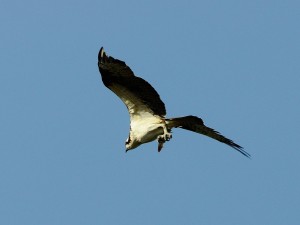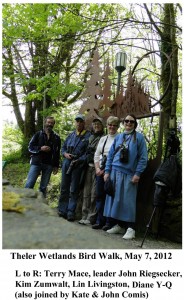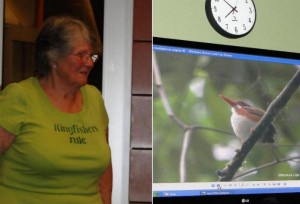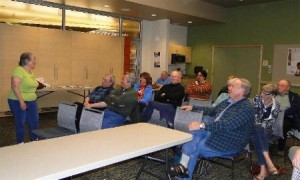I thought as the peak of spring migration is just around the corner it is timely to put up notes from a previous spring class. The most recent relatively complete notes I have is the 2010 spring class, as in 2011 I just listened and used old notes.
4-20-10 Class #1 Spring
Field Trips:
This class will be more of an impressionistic class
Bring the shorebirds molt and voice worksheet to class each time.
Strategies for molt.
Simple basic- start in juvenile, go a year in juvenile, then have one molt annually into a basic plumage. (like hawks)
Complex basic: juvenile à formative plumage, the annual molt into basic plumage. (like towhee)
Simple alternate: juvenile à pre alternate moltà pre basic à … (like loons?)
Complex Alternate: Juvenileà formativeà pre-alternateà pre basic à pre alternateà … (like most songbirds)
Pre-basic molt is complete, all feathers.
Pre-alternate molt is incomplete, usually not flight feathers, other feathers vary by species.
Short distance migrants molt on breeding grounds or in staging areas. Long distance migrants may start molt on breeding grounds, then suspend the molt, and finish on the wintering ground as they cannot both migrate and molt simultaneously.
Birds have a complete molt in the fall
Birds have an incomplete in spring into alternate head, body, all scapulars, and maybe some wing feathers.
Terms used to describe the extent of a molt, usually the pre-alternate molt:
Partial: head, in spring into alternate head body, few covets and some scapulars
Limited: in spring into alternate head and a few body feathers
These are the common Western WA shorebirds you should know for our upcoming trip. BBPL, both yellowlegs, dowichers, dunlin, Least SP, Western SP à plan to know these by voice before the coast trip.
A Shorebird year starting Jan 1:
As early as Jan and as late as June, shorebirds are entering pre-alternate molt. By the time shorebirds get to WA the adults are usually in full alternate plumage. Most juveniles stay on wintering grounds, but some young birds may migrate in their basic plumage and others of the same species may have a PA molt into an adult or near adult alternate plumage.
The migration thru WA is in a rush, usually in late April- early May.
Adults usually nest as soon as they get to breeding grounds, usually in mid may to early June.
Failed breeders and some young birds almost immediately head back.
Young birds are in downy plumage for about a month and then go into juvenile plumage.
First after failed breeders back are females in worn plumage, followed by males in worn plumage a week or so later. Then a week or two later, or sometimes much later, are bright fresh juveniles. Going on their own, at 1-2 months of age.
PB molt in some adults can start as a limited molt even on the nest, or on the breeding ground.
Suspend molt of remiges (flight feathers in spring into alternate head) and rectrices (tail feathers) until on or near the breeding ground.
On wintering grounds birds finish their wing and tail molt. Those who winter in NA may finish their molt at stopovers.
Juveniles start their PB 1 molt somewhere between Sept and Oct and end by Dec. This is a formative type plumage, incomplete in most species vs. adults having a complete molt into basic plumage.
Impression: Next week come prepared to concisely discuss whatever bird we are identifying.
As a homework assignment do a walk or go into back yard and bird by ear and without binoculars. Use GISS not binos.
We will also work on expected location, time of year, habitat, behavior, relative size, etc.
We will look a lot at structure, legs, bill, neck, wing and primary projection, head structure. Look at feeding behavior, voice.
Last we will look at plumage impression. White belly dowicher is short billed, long billed don’t have white bellies.
Dunlin grayish with a dark breast, Western SP brownish above with white breast.
Get a copy of the Howell Shorebird guide. Much of Ken’s comments are there and so you can avoid the need to take so many notes.
Molt:
Remiges and Rectrices:
Primaries numbered 1-10 and molt begins on the innermost primary (1) and moves outward. Secondaries are numbered outward to inward, and so P1 is beside S1. Secondary molt begins after primary molt is about half way done. It moves from outside in. This results in gaps in the wing feathers. If you see these gaps it usually means the bird will molt in NA. Some birds molt at staging grounds (like LBDO) vs. SBDO does not molt primaries until on the wintering ground.
IN spring you see nice fresh feathers on the head, scapulars and the bodies. Fresh feathers have nice well defined patterns, and old feathers have the fringes and patterns on the edges worn off, sometimes serrated or saw tooth edges. Dark pigments wear tougher, lighter feathers wear faster.
Juveniles have usually white edges on scapulars and coverts.
Old feathers tend to look frayed on the edges and can droop more, not as stiff. As they droop more they eventually fall out. Old feathers tend to be more pointed as they wear, more rounded when they are fresh, and as they wear off the white or buff rounded edges they become more pointed.
Good example of feather wear is the Least Sandpiper. In spring highly patterned with light tipped feathers, very patterned. When they come back in the fall they are darker with less patterning on the top. In August you will see fresh juveniles, and worn adults. Later the juveniles will look more worn, and the adults are going thru PB molt and will look much sharper and fresh.
Species accounts:
Black bellied Plovers: all year have black axillars, wing stripe, the biggest plover, blocky, on mud flats, on open beaches, roost on upper beach, golf courses. Upland species also. More west, but also E of Cascades. 3 syllable loud plaintive Plee-uu-ee lower in pitch than golden plovers. Up until PB2 molt you can age juveniles by their worn primaries. Especially in spring. Listen for calls in flight. GISS, chunky, thick necked, heavier bill than golden plovers, note 240 gm vs. 130-140 grams for goldens. Seen spring and fall.
Pacific Golden Plover: lower pitched, emphasis on second syllable, variable pitch mostly seen in the fall. Buffy, In spring white on flanks, appear to be front heavy, look like they could tip over forward, larger head, rounder body, stand taller, shorter wing projection and longer primary projection of 4 feathers. Have a molt that does not include the primaries. So in the springtime look at the primaries, and in first year pacifics have worn primaries all the way until June or July, so very worn. So if you see a golden plover in spring with worn primaries it is Pacific. Pacific adults molt the inner primaries on the breeding grounds (Americans do not) So inner 5 primaries will be fresh in adults in migration in fall.
American Golden-plover: In spring stripe ends before the flank, more slim, more attenuated, not as plump, longer primary and wing projection. No wing stripe. Dark tailed. One tone note, two syllables. Have a complete fall molt, between Oct- Dec. includes the primaries. First year Americans have fresh primaries. In migration American GPs do not molt their primaries until on the breeding grounds.
Mountain Plover: pale all over, big headed, thick necked, short grass or plowed fields, loose flocks.
Killdeer: slim, long tailed, small bill.
Snowy Plover: drrrp toor-eeet call. Light plovers with dark legs and dark bills, longer and slimmer than semi-palmated, tend to be front heavy.
Piping Plover: two tone bill, orange legs. More attenuated, not front heavy, tiny bill.
Wilson’s Plover: light legs, dark above, larger and front heavy, large head and bill, thick bill. Usually on upper beach.
Semi-palmated Plover: two syllable note, chu-eep. Come through very early in the fall, often in July.
Black Oystercatcher: Bulky, short thick neck, long thick bill
American Oystercatcher: southern coasts, sandy beaches, two toned, also mud flats.
American Avocet: Alkali ponds, E WA, rare in migration on W side, larger than black necked stilts. Chunky. Loud PLEET CALL. Gather in large groups to molt in migration in fall.
Black-necked Stilt: slim body, long legs, needle-like bill, alkali ponds, very rare in migration on W side. Yip-Yip-Yip loud call
Greater Yellowlegs: higher more strident 3 noted call Two times the weight of lesser, long upturned bill, look like they have an Adams apple, bulge on front of the neck. Pick and chase. Scurry around the pond. Seen all year round, numerous spring and fall. Pattern above and stripes on upper neck.
Lesser Yellowlegs: slim-chested, smooth body contour, straight bill, more methodical scything movements as it walks, usually does not run. Walks steadily. Unusual in spring, either E or W side. Usually fresh water ponds. Seen as early as July 1 in fall thru. Sept. rare after September.





